ESP CHEVROLET MONTE CARLO 1997 5.G Owners Manual
[x] Cancel search | Manufacturer: CHEVROLET, Model Year: 1997, Model line: MONTE CARLO, Model: CHEVROLET MONTE CARLO 1997 5.GPages: 358, PDF Size: 19.11 MB
Page 10 of 358

Downloaded from www.Manualslib.com manuals search engine Supplement to the 1997 Chevrolet Lumina and Monte Carlo Owner’s Manuals
This is a correction to information found on page 2-34 and 2-35 (Lumina) and page 2-34 (Monte Carlo).
Daytime Running Lamps / Automatic
Headlamp Control
Daytime Running Lamps (DRL) can make it easier
for others to
see the front of your vehicle during the
day. DRL can be helpful in
many different dnving
conditions, but they can be especially helpful in the
short periods after dawn and before sunset.
A light sensor on top of the instrument panel makes
the DRL work,
so be sure it isn’t covered.
The DRL system will make your high-beam headlamps
come on at a reduced brightness when:
The ignition is on,
The headlamp switch is off and
The parking brake is released.
97LUMWCARL0001 When
the DRL
are on, only your reduced intensity
high-beam headlamps will be on. The taillamps,
sidemarker and other lamps won’t be on. Your
instrument panel won’t be
lit up either.
When it’s dark enough outside, your DRL will turn off
and your low-beam headlamps will turn on. The other
lamps that come on with your headlamps will also
come on.
When it’s bright enough outside, the low-beam
headlamps will go out and DRL turns on your
high-beam headlamps at reduced intensity.
To idle your vehicle with the DRL off, set the parking
brake while the ignition is in
OFF or LOCK. Then start
your vehicle. The DRL will stay off until you release
the parking brake.
As with any vehicle, you should turn on the regular
headlamp system when you need it.
1
Page 24 of 358

Downloaded from www.Manualslib.com manuals search engine or the safety belts!
With safety belts, you slow down as the vehicle does.
You get more time to stop.
You stop over more distance,
and your strongest bones take the forces. That’s why
safety belts make such good sense.
Here Are Questions Many People Ask
About Safety Belts -- and the Answers
&: Won’t I be trapped in the vehicle after an
accident if I’m wearing a safety belt?
A: You could be -- whether you’re wearing a safety
belt or not. But
you can unbuckle a safety belt,
even if you’re upside down. And your chance of
being conscious during and after an accident,
so
you can unbuckle and get out, is much greater if
you are belted.
&: If my vehicle has air bags, why should I have to
A: Air bags are in many vehicles today and will be in
most of them in the future. But they are
supplemental systems only;
so they work with
safety belts -- not instead of them. Every air bag
system ever offered for sale has required the
use of
safety belts. Even
if you’re in a vehicle that has air
bags,
you still have to buckle up to get the most
protection. That’s true not only
in frontal collisions,
but especially
in side and other collisions.
wear safety belts?
Page 63 of 358
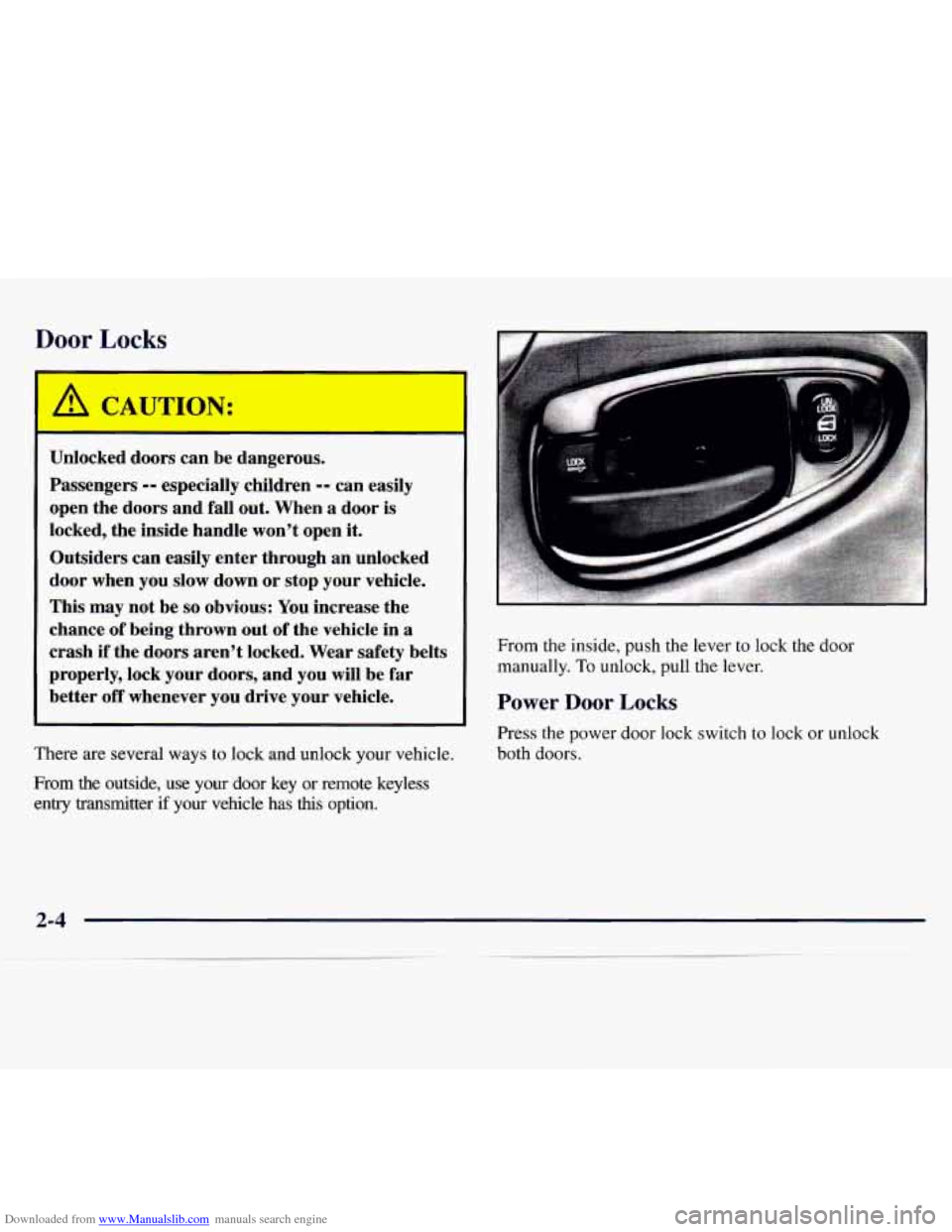
Downloaded from www.Manualslib.com manuals search engine Door Locks
-
Unlocked doors can be dangerous.
Passengers
-- especially children -- can easily
open the doors and fall out. When a door is
locked, the inside handle won’t open it.
Outsiders can easily enter through an unlocked
door when you slow down or stop your vehicle.
This may not be
so obvious: You increase the
chance
of being thrown out of the vehicle in a
crash if the doors aren’t locked. Wear safety belts
properly, lock your doors, and you will be far
better
off whenever you drive your vehicle.
’
There are several ways to lock and unlock your vehicle.
From the outside, use your door key or remote keyless
entry transmitter if your vehicle has
this option. From the inside, push the lever to lock the
door
manually.
To unlock, pull the lever.
Power Door Locks
Press the power door lock switch to lock or unlock
both doors.
Page 67 of 358
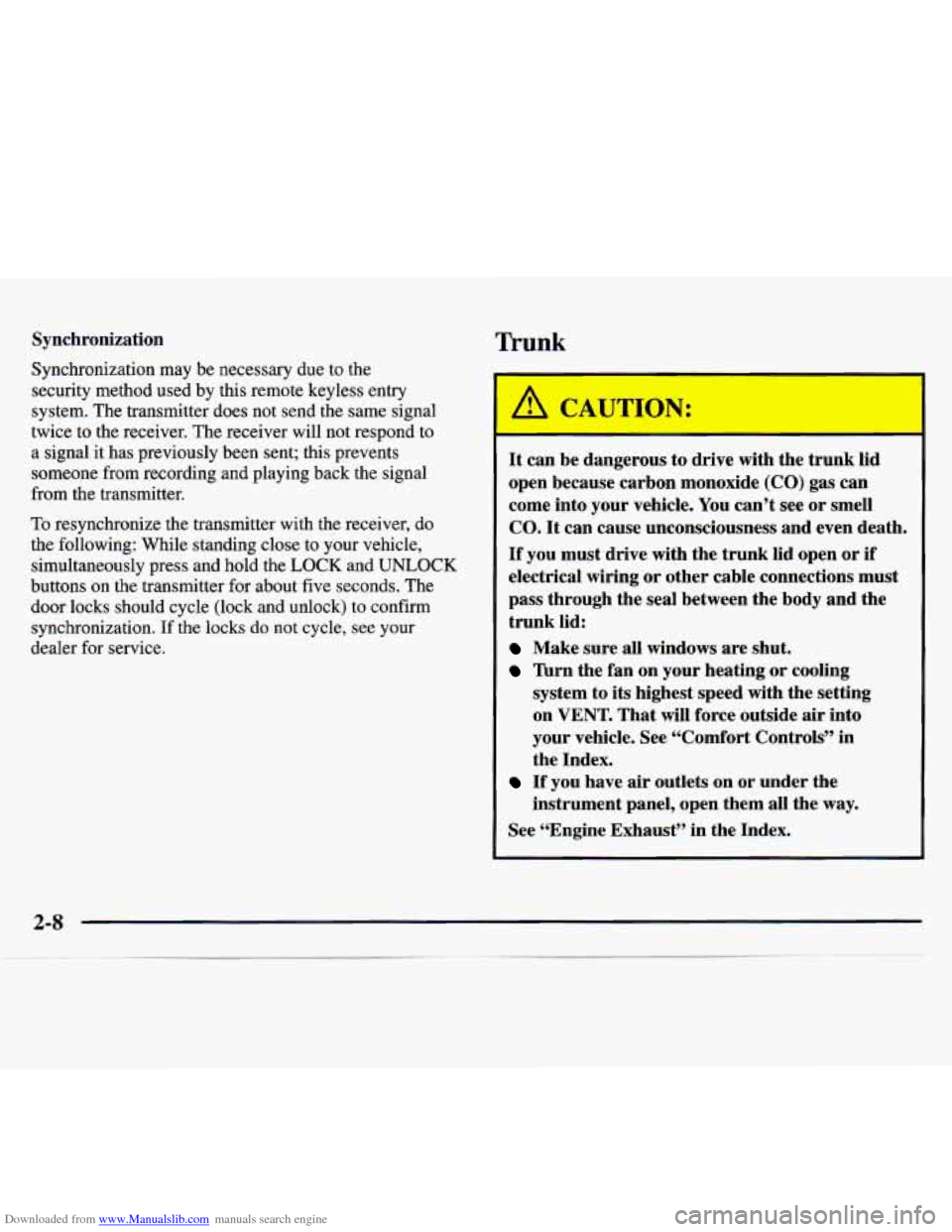
Downloaded from www.Manualslib.com manuals search engine Synchronization
Synchronization may be necessary due to the
security method used by this remote keyless entry
system. The transmitter does not send the same signal
twice to the receiver. The receiver will not respond to
a signal it has previously been sent; this prevents
someone from recording and playing back the signal
from the transmitter.
To resynchronize the transmitter with the receiver, do
the following: While standing close to your vehicle,
simultaneously press and hold the
LOCK and UNLOCK
buttons on the transmitter for about five seconds. The
door locks should cycle (lock and unlock) to confirm
synchronization. If the locks
do not cycle, see your
dealer for service.
Trunk
-
It can be dangerous to drive with the trunk lid
open because carbon monoxide (CO) gas can
come into your vehicle. You can’t see or smell
CO. It can cause unconsciousness and even death.
If you must drive with the trunk lid open or if
electrical wiring or other cable connections must
pass through the seal between the body and the
trunk lid:
Make sure all windows are shut.
nrn the fan on your heating or cooling
system to its highest speed with the setting
on
VENT. That will force outside air into
your vehicle. See “Comfort Controls’’ in
the Index.
instrument panel, open them all the way.
If you have air outlets on or under the
See “Engine Exhaust” in the Index.
Page 68 of 358

Downloaded from www.Manualslib.com manuals search engine Trunk Lock
To unlock the trunk from
the outside, insert the door
key and turn it. You can
also use the remote keyless
entry function if your
vehicle has this option.
Just press the trunk symbol
on the transmitter, making
sure your shift lever is in
PARK
(P).
Remote Trunk Release (Option)
Press the button under the
instrument panel on the
driver’s side. Your transaxle
shift lever must be in
PARK (P).
Remember, your trunk can be opened at any time using
this lock release,
so be sure to lock your doors.
Theft
Vehicle theft is big business, especially in some
cities. Although your Chevrolet has
a number of
theft-deterrent features, we know that nothing we put
on it can make
it impossible to steal. However, there are
ways you can help.
Key in the Ignition
If you leave your vehicle with the keys inside, it’s an
easy target for joy riders or professional thieves
-- so
don’t do it.
When ydu @ark your Chevrolet and open the driver’s
door, you’ll hear a chime reminding you to remove your
key from the ignition and take it with you. Always
do
this. Your steering wheel will be locked, and so will
your ignition and transaxle. And remember
to lock
the doors.
Page 93 of 358
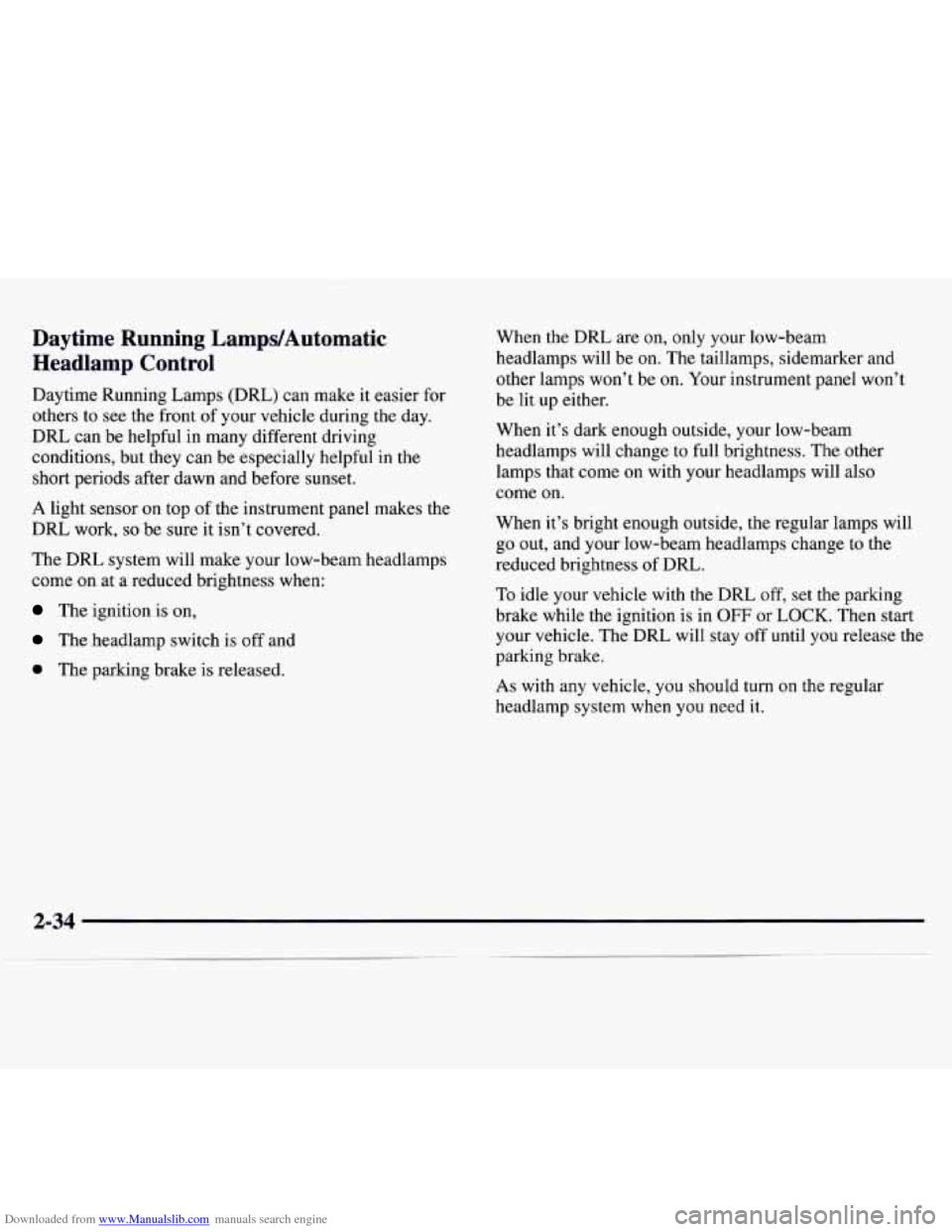
Downloaded from www.Manualslib.com manuals search engine Daytime Running LampdAutomatic Headlamp Control
Daytime Running Lamps (DRL) can make it easier for
others to see the front of your vehicle during the day.
DRL can be helpful in many different driving
conditions, but they can be especially helpful
in the
short periods after dawn and before sunset.
A light sensor on top of the instrument panel makes the
DRL work,
so be sure it isn’t covered.
The
DRL system will make your low-beam headlamps
come on at a reduced brightness when:
The ignition is on,
The headlamp switch is off and
0 The parking brake is released. When the
DRL are on, only your low-beam
headlamps will be on. The taillamps, sidemarker and
other lamps won’t be on. Your instrument panel won’t
be lit up either.
When it’s dark enough outside, your low-beam
headlamps will change to full brightness. The other
lamps that come on with your headlamps will also
come
on.
When it’s bright enough outside, the regular lamps will
go out, and your low-beam headlamps change to the
reduced brightness of DRL.
To idle your vehicle with the DRL off, set the parking
brake while the ignition
is in OFF or LOCK. Then start
your vehicle. The DRL will stay off until you release the
parking brake.
As with any vehicle, you should turn on the regular
headlamp system when you need it.
Page 137 of 358

Downloaded from www.Manualslib.com manuals search engine Understanding Radio Reception
FM Stereo
FM stereo will give you the best sound. But FM signals
will reach only about 10
to 40 miles (16 to 65 km). Tall
buildings or hills can interfere with FM signals, causing
the sound to come and go.
AM
The range for most AM stations is greater than for FM,
especially at night. The longer range, however, can
cause stations
to interfere with each other. AM can pick
up noise from things like storms and power lines. Try
reducing the treble to reduce this noise if you ever get it.
Tips About Your Audio System
Hearing damage from loud noise is almost undetectable
until
it is too late. Your hearing can adapt to higher
volumes of sound. Sound that seems normal can be loud
and harmful to your hearing. Take precautions by
adjusting the volume control on your radio
to a safe
sound level before your hearing adapts to
it.
To help avoid hearing loss or damage:
Adjust the volume control to the lowest setting.
Increase volume slowly until you hear comfortably
and clearly.
NOTICE:
Before you add any sound equipment to your
vehicle
-- like a tape player, CB radio, mobile
telephone or two-way radio
-- be sure you
can add what you want.
If you can, it’s very
important to do it properly. Added sound
equipment may interfere with the operation
of your vehicle’s engine, Delco radio
or other
systems, and even damage them. Your
vehicle’s systems may interfere with the
operation
of sound equipment that has
been added improperly.
So, before adding sound equipment, check with
your dealer and be sure to check Federal rules
covering mobile radio and telephone units.
Page 144 of 358
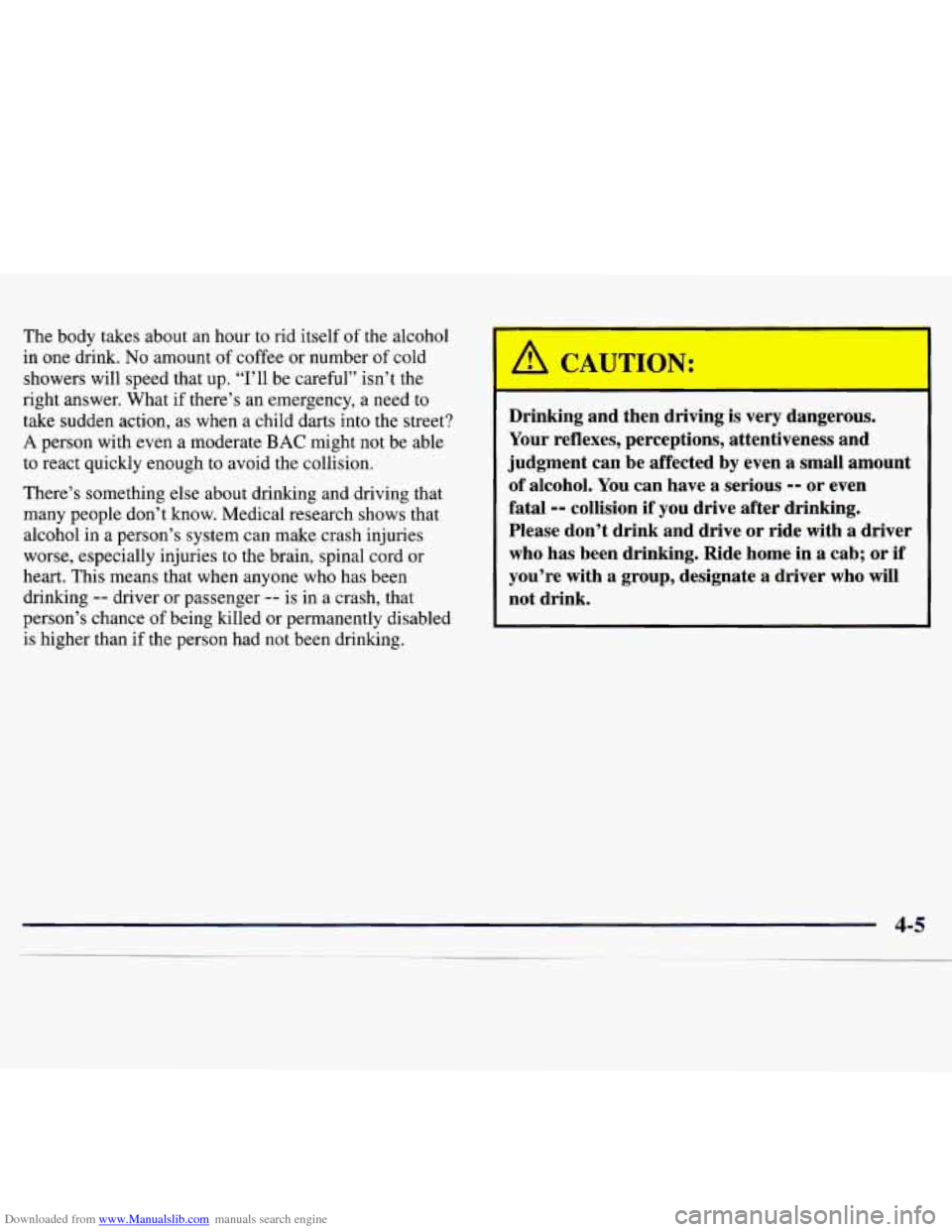
Downloaded from www.Manualslib.com manuals search engine The body takes about an hour to rid itself of the alcohol
in one drink. No amount of coffee or number of cold
showers will speed that up. “I’ll be careful” isn’t the
right answer. What if there’s an emergency, a need to
take sudden action, as when a child darts into the street?
A person with even a moderate BAC might not be able
to react quickly enough to avoid the collision.
There’s something else about drinking and driving that
many people don’t know. Medical research shows that
alcohol in a person’s system can make crash injuries
worse, especially injuries
to the brain, spinal cord or
heart. This means that when anyone who has been
drinking
-- driver or passenger -- is in a crash, that
person’s chance
of being killed or permanently disabled
is higher than
if the person had not been drinking.
I A CAUTION:
Drinking and then driving is . -ry dangerous.
Your reflexes, perceptions, attentiveness and
judgment can be affected
by even a small amount
of alcohol. You can have a serious
-- or even
fatal
-- collision if you drive after drinking.
Please don’t drink and drive or ride with
a driver
who has been drinking. Ride home in a cab; or
if
you’re with a group, designate a driver who will
not drink.
Page 151 of 358
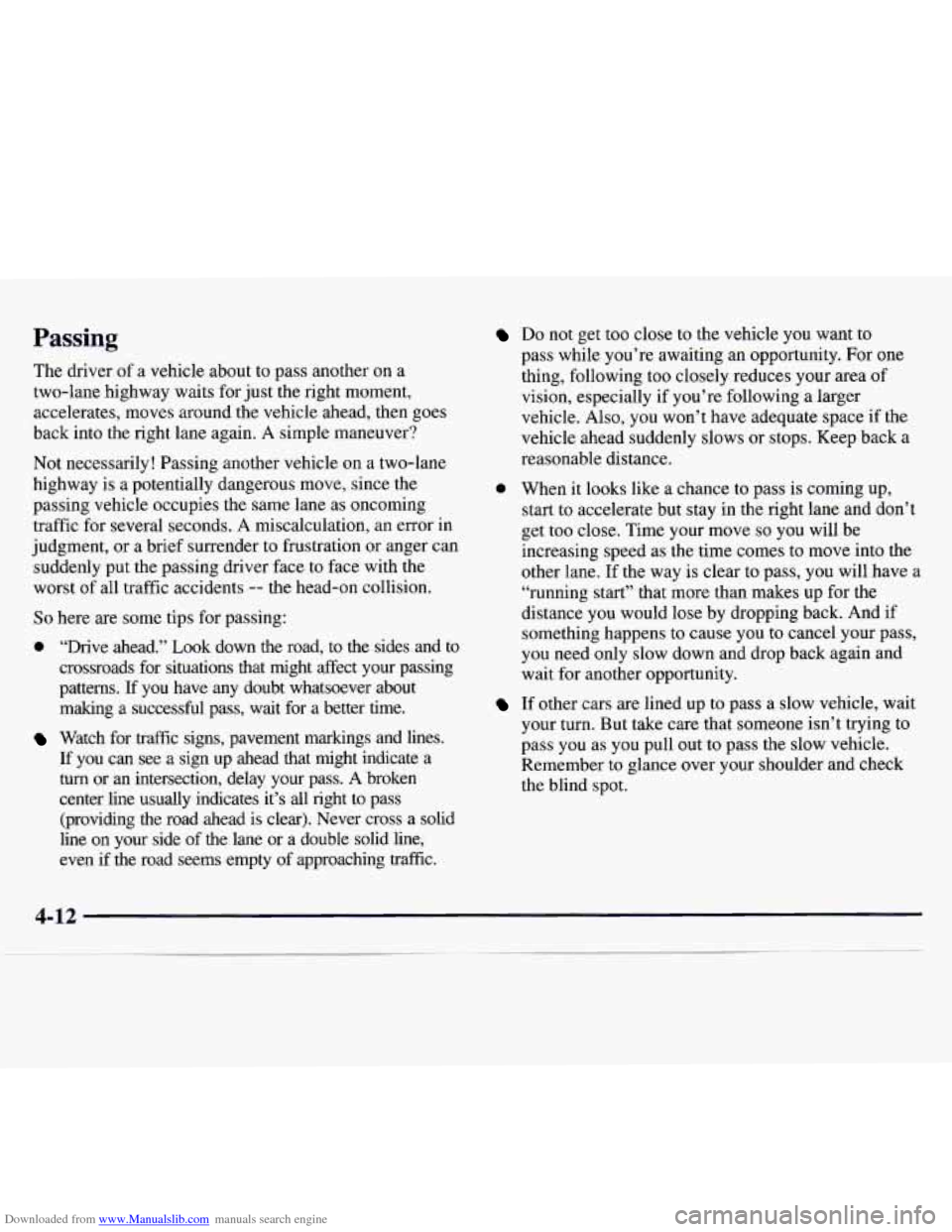
Downloaded from www.Manualslib.com manuals search engine Passing
The driver of a vehicle about to pass another on a
two-lane highway waits for just the right moment,
accelerates, moves around the vehicle ahead, then goes
back into the right lane again. A simple maneuver?
Not necessarily! Passing another vehicle on a two-lane
highway
is a potentially dangerous move, since the
passing vehicle occupies the same lane
as oncoming
traffic for several seconds.
A miscalculation, an error in
judgment, or
a brief surrender to frustration or anger can
suddenly put the passing driver face to face with the
worst
of all traffic accidents -- the head-on collision.
So here are some tips for passing:
0 “Drive ahead.” Look down the road, to the sides and to
crossroads for situations that might affect your passing
patterns.
If you have any doubt whatsoever about
making a successful pass, wait for a better time.
Watch for traffic signs, pavement markings and lines.
If you can see a sign up ahead that might indicate a
turn or an intersection, delay your pass. A broken
center line usually indicates it’s all right to pass
(providing the road ahead
is clear). Never cross a solid
line on your side
of the lane or a double solid line,
even if the road seems empty of approaching trafic.
Do not get too close to the vehicle you want to
pass while you’re awaiting an opportunity. For one
thing, following too closely reduces your area
of
vision, especially if you’re following a larger
vehicle. Also, you won’t have adequate space if the
vehicle ahead suddenly slows or stops. Keep back
a
reasonable distance.
0 When it looks like a chance to pass is coming up,
start
to accelerate but stay in the right lane and don’t
get too close. Time your move
so you will be
increasing speed as the time comes to move into the
other lane. If the way is clear to pass, you will have a
“running start” that more than makes up for the
distance you would
lose by dropping back. And if
something happens to cause you to cancel your pass,
you need only slow down and drop back again and
wait for another opportunity.
If other cars are lined up to pass a slow vehicle, wait
your turn. But take care that someone isn’t trying to
pass you as you pull out to pass the slow vehicle.
Remember to glance over your shoulder and check
the blind spot.
Page 152 of 358
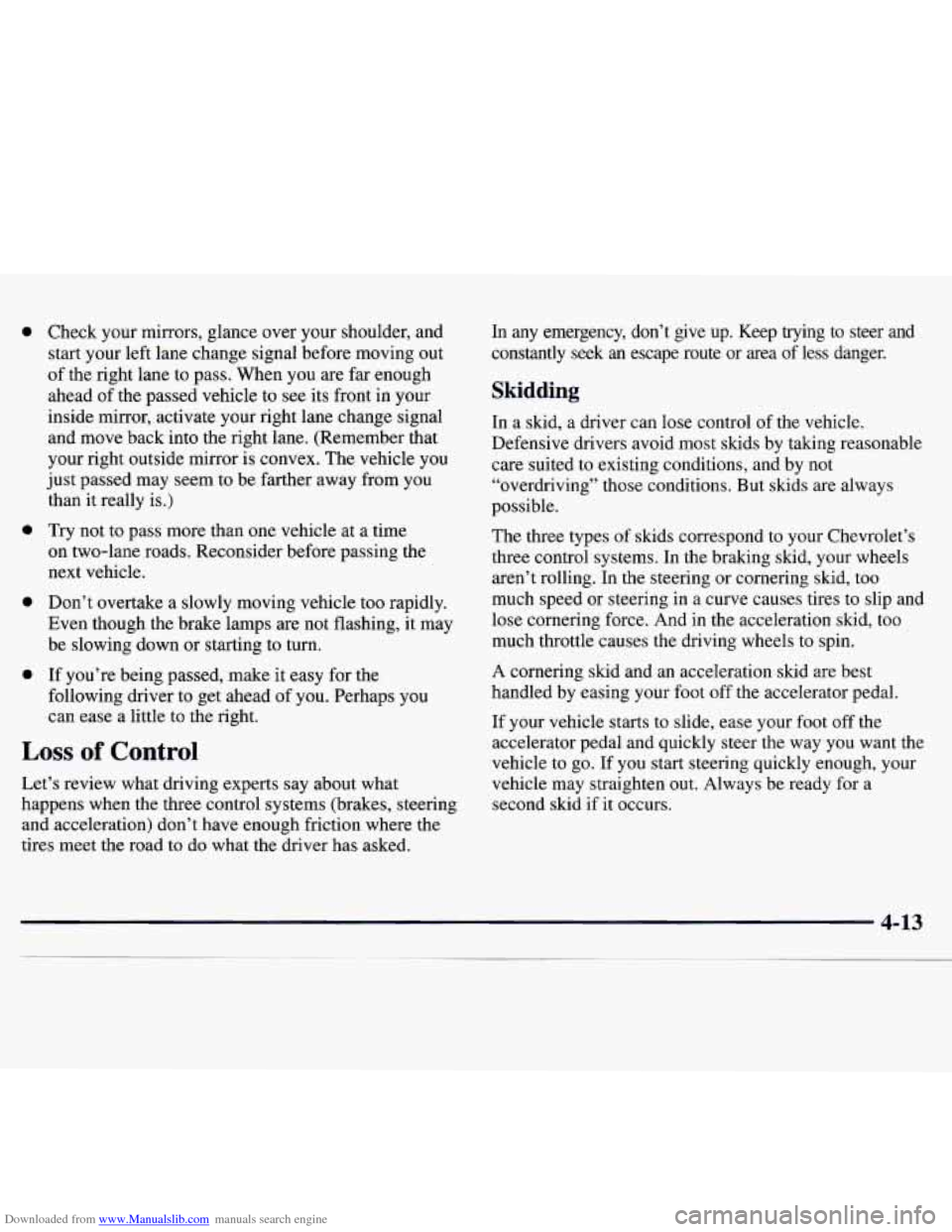
Downloaded from www.Manualslib.com manuals search engine e
0
0
0
Check your mirrors, glance over your shoulder, and
start your left lane change signal before moving out
of the right lane to pass. When you are far enough
ahead of the passed vehicle to see its front in your
inside mirror, activate your right lane change signal
and move back into the right lane. (Remember that
your right outside mirror is convex. The vehicle you
just passed may seem to be farther away from you
than
it really is.)
Try not to pass more than one vehicle at a time
on two-lane roads. Reconsider before passing the
next vehicle.
Don’t overtake a slowly moving vehicle too rapidly.
Even though the brake lamps
are not flashing, it may
be slowing down or starting to turn.
If you’re being passed, make it easy for the
following driver to get ahead of you. Perhaps you
can ease a little to the right.
Loss of Control
Let’s review what driving experts say about what
happens when the three control systems (brakes, steering
and acceleration) don’t have enough friction where the
tires meet
the road to do what the driver has asked. In any emergency, don’t give up. Keep trying
to steer and
constantly seek an escape route or area of less danger.
Skidding
In a skid, a driver can lose control of the vehicle.
Defensive drivers avoid most skids by taking reasonable
care suited to existing conditions, and by not
“overdriving” those conditions. But skids are always
possible.
The three types of skids correspond to your Chevrolet’s
three control systems. In the braking skid, your wheels
aren’t rolling. In the steering or cornering skid, too
much speed or steering in a curve causes tires to slip and
lose cornering force. And in the acceleration skid, too
much throttle causes the driving wheels to spin.
A cornering skid and an acceleration skid are best
handled by easing your foot off the accelerator pedal.
If your vehicle starts to slide, ease your foot
off the
accelerator pedal and quickly steer the way you want the
vehicle to go. If you start steering quickly enough, your
vehicle may straighten out. Always be ready for a
second skid if it occurs.